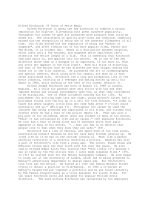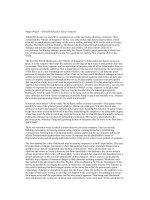alfred hitchcock at 100
Bạn đang xem bản rút gọn của tài liệu. Xem và tải ngay bản đầy đủ của tài liệu tại đây (40.67 KB, 2 trang )
Queen Victoria was still on the throne when Sir Alfred Hitchcock was born in London a hundred
years ago this month. A massively fat man of relentlessly old-fashioned demeanor, schooled by
Jesuits and formal to the point of paralysis, he spent his entire adult life working in a medium that
barely existed in 1899, but has since come to be regarded as the very essence of modernity. From
1939 until his death in 1980, he lived in Hollywood, a city that inverts every value of the lost
world into which he was born. He made movies about secret agents and serial killers, and peopled
them with debonair gentlemen who slept with cool blondes, thereby amusing millions of
unsuspecting filmgoers with his own hopeless fantasies; he longed to be the witty, unflappable
Cary Grant of North by Northwest, but knew he was really the Jimmy Stewart of Vertigo, haunted
and desperate.
Today, when the tempo of cultural change has accelerated beyond the wildest dreams of the
maddest prophets, Hitchcock remains a fixed star of American popular culture, the only director
of his generation whose name is still as familiar to ordinary moviegoers as it is to the film- studies
cranks who churn out ponderous tomes with titles like Hitchcock as Activist: Politics and the War
Films and Hitchcock's Bi-Textuality: Lacan, Feminisms, and Queer Theory. But it was not always
so. Witness, for instance, this testy review of Secret Agent, his 1936 adaptation of Somerset
Maugham's Ashenden:
His films consist of a series of small "amusing" melodramatic situations: the murderer's buttons
dropped on the baccarat board; the strangled organist's hands prolonging the notes in the empty
church; the fugitives hiding in the bell tower when the bell begins to swing. Very perfunctorily he
builds up to these tricky situations (paying no attention on the way to inconsistencies, loose ends,
psychological absurdities) and then drops them; they mean nothing: they lead to nothing.
This review, as it happens, was written by a novelist, Graham Greene, and it is interesting that he
should point with distaste to the aspect of Hitchcock's work that is now most admired by critics:
the fact that his movies deal primarily in images, not words. It isn't that his characters never say
anything memorable. (Cary Grant, in North by Northwest: "Apparently the only performance
that's going to satisfy you is when I play dead." James Mason: "Your very next role. You'll be
quite convincing, I assure you.") But it is not what they say that we remember after the lights come
up. An elegantly dressed man running through a deserted cornfield, chased by a renegade
cropduster; a broken wine bottle that inexplicably proves to be filled with sand; the blankly staring
eye of a woman lying dead in a running shower-such is the stuff of which a Hitchcock film is
made, and next to it, everything else is window dressing.
Though only nine of his feature films were silent, Hitchcock was profoundly affected by the
silent-film aesthetic, and spent the rest of his career trying to import it into the age of sound. It
took him long enough-many of his pre-1950 films are quite talky-but by the time of Strangers on a
Train, he had figured out how to structure his scripts so as to diminish sharply the importance of
dialogue. Characteristic of Hitchcock is that so many of his strongest films pivot around a tiny plot
twist, uninteresting in itself, that serves as a pretext to set the characters in motion, and even more
so that those characters should not infrequently go through entire scenes without speaking a single
word out loud. Typical, too, is the remark he made to Ernest Lehman, who wrote North by
Northwest, midway through the shooting of that film:The audience is like a great organ that you
and I are playing. At one moment we play this note on them and get this reaction, and then we
play that chord and they react that way. And someday we won't even have to make a movie-there'll
be electrodes implanted in their brains, and we'll just press different buttons and they'll go
"ooooh" and "aaaah" and we'll frighten them, and make them laugh. Won't that be wonderful?
Hitchcock's image-oriented style cut against the grain of filmmaking in the '30s and '40s, which
had been transformed almost beyond recognition by the coming of sound. It is no coincidence that
radio, which flourished at the same time, made effective use of nearly every Hollywood star of the
day; even Citizen Kane, a movie bristling with indelible images, was no less strongly influenced
by Orson Welles's experience as a radio director. Small wonder that at a time when scripts were
still known as "photoplays," Hitchcock's emphasis on the visual should have caused his work to be
widely dismissed as mere light entertainment.
Not until the '60s, after European directors had taken the lead in pulling away from the traditional
style of cinema that dominated Hollywood in its golden age, did Hitchcock begin to be
acknowledged as a major figure. Yet the irony is that his sensibility is decidedly pre- modern, not
merely in its silent-film roots, but also in its emotional tone. A movie like Vertigo, which at first
glance appears to be a kind of film noir, actually differs greatly from such earlier examples of the
genre as Jacques Tourneur's Out of the Past or Nicholas Ray's In a Lonely Place in that its mode
of expression is essentially Gothic-even operatic.
Herein lies a crucial difference between the films of Hitchcock's major phase and the less mature
ones that preceded them: Starting in 1954, he began to work with a composer capable of filling the
empty spaces of his near-silent scenes with music fully in keeping with his own distinctive
sensibility. To watch Ray's On Dangerous Ground, the lone film noir scored by Bernard
Herrmann, is to realize what a difference his nervously yearning music made to Vertigo, North by
Northwest, and Psycho, which are for all intents and purposes collaborations between Hitchcock
and Herr-mann. Remarkable as these films are, their impact would have been considerably
diminished had the director instead been working with such talented but essentially conventional
film composers as Roy Webb (who scored Notorious) or Dmitri Tiomkin (who scored Shadow of
a Doubt and Strangers on a Train).
Significantly, only four of Hitchcock's earlier films-Shadow of a Doubt, Notorious, Strangers on a
Train, and Rear Window-are comparable in force and concentration to the three key
collaborations with Herrmann. That is not a very long list for a man who directed 55 movies in 51
years, and it leads one to view with suspicion the now-general consensus that his films are "great"
works of art. To be sure, there are films as great as the greatest plays or operas or ballets, but
fewer than is commonly thought; most people who write about movies, as John Simon has pointed
out, are "enthusiasts or fantasts who either worship all films or conceive of film criticism as a
means of justifying irrelevant cravings," and are thus inclined to ascribe greatness with
ill-informed abandon. If Strangers on a Train is a "great" movie, then what adjective can rightly be
used to describe, say, Jean Renoir's The Rules of the Game? Mega-great? Measured against the
golden yardstick of true greatness, Hitchcock comes up short. For all his undeniable gifts, he is too
emotionally constricted, too obsessional, to be seriously compared to Shakespeare or Verdi or
Balanchine (or Renoir, for that matter). His films, even the best of them, are melodramas played
out on the narrowest of stages, returning again and again to the same short list of feelings. Guilt,
fear, longing: We expect more of a genius than that. Yet his iconic images lodge permanently in
the minds of all who see them, and surely that is a kind of greatness that cannot be denied. Call
him, then, a major minor master, one who succeeded in spinning out of his tormented inner life a
body of work incapable of expanding our own imaginative worlds, but that nonetheless retains its
dreamlike power to frighten and enthrall.









